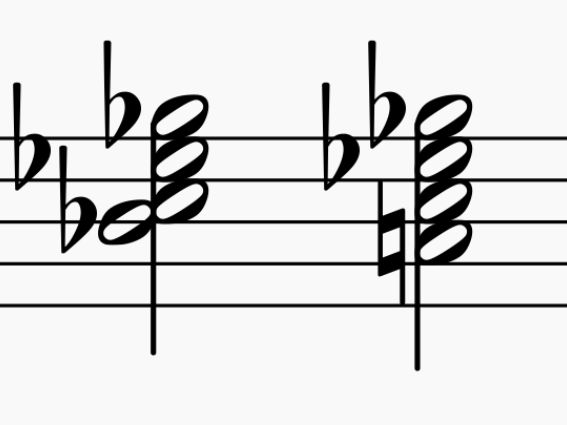Search the Community
Showing results for tags 'chromatic'.
-
Good evening, I am working on an SATB "practice" arrangement - I like to make applied compositional projects for myself when learning new theory concepts. I am trying to incorporate some more chromatic harmony into this SATB piece, the main spots I'm having some trouble with are the 3rds system on the second page, and the circled measures. 1. I want to write in a viio7/V, but what comes next is meant to be a I-V7 move, with passing tones in the A, T, and B to change chords. I've attached a sample of other chords that might work there. I'm aiming for something "big" before moving into the last phrase. I considered a CTdim7 or an Augmented 6th chord 2. I always struggle with changing chords using inner voices, so that's what I'm trying to work on here - I considered having an Eb-Edim7-Bb/F, but not totally sure on that A - Bb C C# / D in alto next measure OR A- - Bb C C# / D in alto next measure T - G G G / Ab OR T - G G Ab / Bb B - E E Enat./ F OR B - E E Enat./ F 3. Some embellishments to the I 4-3 suspension at the end of the piece.
- 3 replies
-
- chromaticism
- chromatic
-
(and 1 more)
Tagged with:
-
This is one of the few pieces I've written that I can actually play, but unfortunately I lack the equipment to record myself playing at any reasonable quality. Most of this was written all in one go, following inspiration rather than any concrete form or plan. I've never come across a satisfying way of notating what I explain in the first note; staccato isn't the same thing and a caesura, though closer, would usually be too long.
-
What is your opinion on using chromatic notes from time to time to help adjust a melody? Or just writing something that isn't quite all modal?
- 4 replies
-
- chromatic
- non-modal melodies
-
(and 3 more)
Tagged with:
-
Hello Everyone, I wrote this piece out of boredom today and is sort of an experimental piece on timpani and the effect of chromatics and scale stacking. Hope you enjoy it! Best, HoYin
-
1º Bagatelle.mid 2º Bagatelle.mid 3º Bagatelle.mid
-
Hi Iam 22 years old amateur "just for joy" composer and I would like to get some feedback from you. This is my new piano only piece (usually make larger ensembles). Original chromatic melody in A minor-harmonic scale. All 11 halftones used in this piece, makes it more mysterious but not so false hope :D . Faded in and out with gentle rain. Recorded on soft upright piano called "UnaCorda".
-
I've been working on an opera project with some colleagues for a long while, and some of it requires custom notation. After much discussion, we’ve come up with notation for chromatic/atonal mordents pictured above. These would completely replace the classical mordents we know from the Baroque, since frequent use has made it necessary to always specify the interval at which the ornament is. I would like to know what you think of these, if they seem sensible and functional to you, or not. For vote-counting convenience, please VOTE HERE. If you vote no, please also explain why in a comment. Thank you.
-
Hey again everyone Probably a stupid question but I would appreciate an answer. I think maybe this is just a case of using your ear, but if there is some theory behind it it would cool to be pointed in the right direction. When I write chord progressions I stick with the diatonic chords and use chromatic chords when I want something "out there" However i have recently been listening to this piece and have noticed the chords don't seem to be based on a scale, but it all flows very well. http://www.youtube.com/watch?v=7OSjxWJuuqQ For 0:00 - 0:18 it's alternating between D and Am At 0:22 it goes to Bb Then at 0:25 it goes at Gm Finally at 0:29 it goes to D There isn't a scale with all these chords, yet they work incredibly well. The melody also seems to change into different scales but it still sounds incredibly fluid, no note sticks out. I would love to be able to doing something like this, but like I said when I do anything outside of he scale I'm either the chords or the melody stick out more than I would like. Looking at the chords above, is there a reason (probably really obvious :headwall: ) they flow so well with the melody? Thanks for your time, this forum has been a great help for me.







